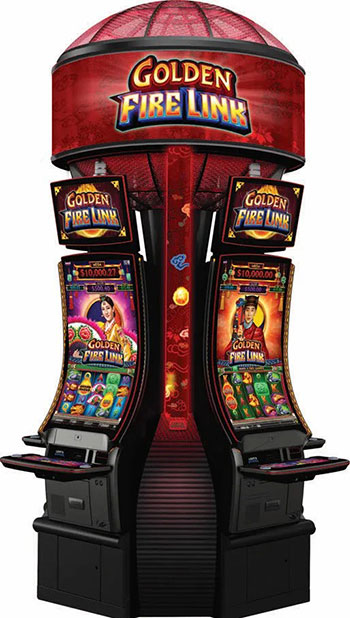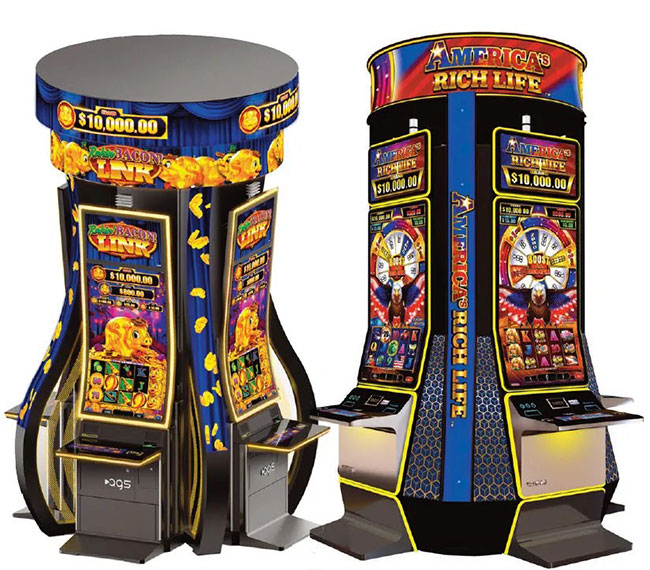THE NEW LOOK
From pods to cabinets, the slot floor has come a long way
By Frank Legato

Slot floors just aren’t what they used to be.
When one considers the evolution of the physical slot floor over the past few decades, what reveals itself is a shift in look and feel that first developed because of the changing styles of the games themselves.
When slots experienced their first burst of popularity in the 1980s, the change was not apparent to the naked eye. In the early 1980s, slots became computerized with the “virtual reel” system. The physical reels became nothing more than display mechanisms to show the results of freezing, with each spin, a sequence of numbers, each related to a particular reel result.
 What this meant to slot play was that jackpots became larger, because the use of duplicate numbers related to each reel symbol stretched the odds that one would score the highest results. Longer odds meant jackpots that previously topped out under $1,000 could stretch into the tens of thousands, or, in the case of multi-site progressives, the hundreds of thousands and even the millions.
What this meant to slot play was that jackpots became larger, because the use of duplicate numbers related to each reel symbol stretched the odds that one would score the highest results. Longer odds meant jackpots that previously topped out under $1,000 could stretch into the tens of thousands, or, in the case of multi-site progressives, the hundreds of thousands and even the millions.
Even with this monumental development, though, the look and the atmosphere of your average slot floor did not change at first. By and large, the machines all looked the same, with three mechanical reels displaying bar combinations, 7s, maybe cherries, and a few wild symbols.
The advent of multi-line video slots in the 1990s provided the first change to the look of the floor. These games were more angular, more boxy, than the mechanical reel-spinners. Video animation now provided a new, distinctive glow to many of the machines. Along with video poker, the slots provided a greater mix of visuals—mechanical reels varying with the glowing video monitors.
While big changes in slot cabinets were still to come, the slot floors of the early 2000s into the mid-2010s maintained one overriding similarity to those earlier floors—the accepted practice of casino slot managers was to cram as many machines onto the floor as would fit. The result was rows and rows of straight slot-machine banks, and an often- uncomfortable crowding of players with their fellow casino-goers.
These were the days when players could often be seen playing two or three machines at once, alternating spins among the games and often hogging large portions of slot banks to themselves.
Over the most recent decade, a few developments completely turned that slot-floor model on its ear.
First, slot manufacturers got really creative with cabinet design. Cabinets with stacked and curved monitors changed the look of the floor. Giant cabinets appeared with bench seats and dual dash buttons. Couples could now play together on one giant machine. The days of players wagering on multiple games at once were suddenly numbered.
Second, the Great Recession of 2008-09 happened. Slot manufacturers began to weed out the slot games that were not making them money.
The need to cut costs led to a revelation—casinos could make as much or more money with fewer games.
With this realization, the layout of the slot floor changed. Long banks of like-sized slot machines evolved into a slot floor with a lot more breathing room between games. Instead of navigating a cramped floor crowded with players in a close environment, the floor became a lot more comfortable. Long slot banks were replaced with groupings of back-to-back slots—three, four or six games to a side.
Advancements like cabinets with large, flat button decks and “ergonomic” designs added to the new, relaxed slot atmosphere.
But what really completed the transformation of the slot floor was the Covid-19 pandemic. After months of unprecedented casino shutdowns, slot managers were suddenly faced with the requirement for “social distancing.”
At first, this meant the eminently unsustainable practice of shutting down every other machine. Soon, though, the slot manufacturers provided a much more sensible solution: “pods.”

In the old days, these were called “slot carousels,” and they were the only exception to the straight rows of machines. Slots would be arranged in a circle, with a jackpot prize—a motorcycle, even a car or a boat— sitting on top of the carousel. Pods would bring back the practice of placing machines in a circle.
But now, the machines are spaced so as to give plenty of room to each player. As a result, today’s slot floors, particularly in the newer properties, provide players a comfortable, uncrowded experience that was not possible in the earlier halcyon days of slot popularity.
So use the automated system to order yourself a drink (it sure beats flagging down cocktail servers!), insert your money, sit back, relax, and play your favorite game.
And thank your lucky stars you’re not crowded into a cramped space like in the old days. It’s not your fathers’ slot floor anymore.


